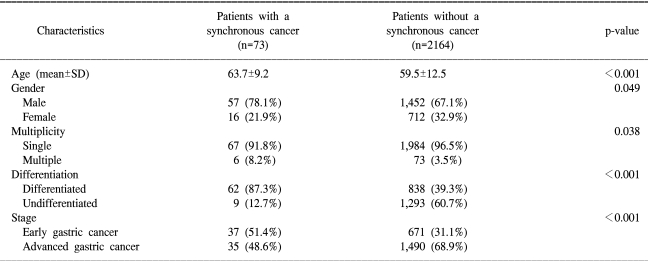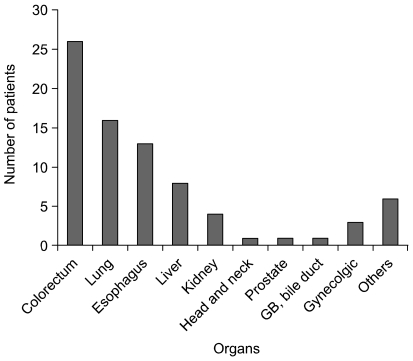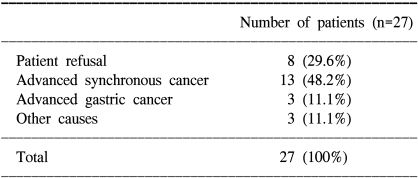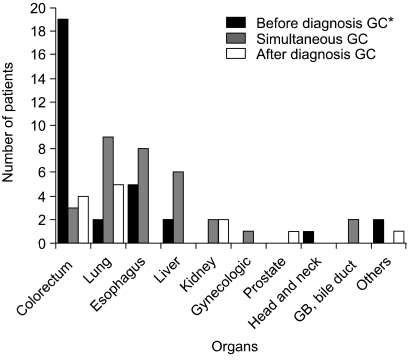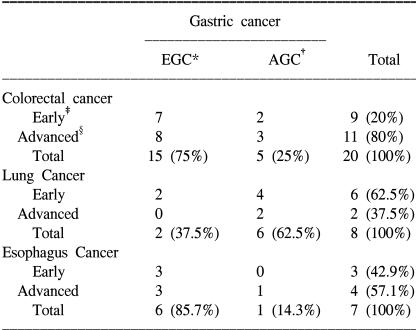Abstract
Purpose
The primary objective of the current study was to investigate the characteristics of synchronous cancers in gastric cancer patients.
Materials and Methods
We analyzed the 2,237 patients who were diagnosed between December 2000 and December 2003 with gastric cancer and synchronous cancers of organs other than the stomach.
Results
73 (3.3%) of a total of 2,237 gastric cancer patients had synchronous primary cancers. Among these 73 patients, 71 had one synchronous cancer, and two patients had double synchronous cancers. Colorectal cancer (26 patients, 34.7%) was the most frequently encountered synchronous cancer, followed by cancer of the lung (16 patients, 21.3%), esophagus (13 patients, 17.2%), and liver (8 patients, 10.7%). Synchronous cancers were detected with increased frequency in the elderly, in the patients with multiple gastric cancers, in the patients with differentiated gastric cancer, and in the patients with early gastric cancer, as determined on univariate analysis, but the differentiation of gastric cancers was the only risk factor for synchronous cancers on the multivariate analysis.
Conclusions
The differentiation of gastric cancer cells may be a risk factor for synchronous cancers in gastric cancer patients. Careful surveillance by the physician for synchronous cancer is warranted for the patients suffering from gastric cancer.
Keywords: Synchronous cancer, Stomach neoplasms, Colorectal neoplasms
INTRODUCTION
Gastric cancer is the most frequently encountered cancer in Korea, and it represents the second most common cause of cancer death (1). The recent outcomes of gastrectomy for patients with stomach cancer have significantly improved as the result of the advances in early detection techniques, the surgical procedures and the perioperative management protocols (2,3). As the number of long-term survivors after gastrectomy increases, a concomitant increase in the incidence of second malignancies after gastrectomy has been noted (4,5).
Second malignancies are clinically relevant with regard to their diagnosis and/or treatment (6,7). Recent advances in early detection and surgical techniques have made it possible to cure the patients who exhibit second malignancies with using minimally invasive techniques. Insufficient vigilance by the physician with regard to synchronous cancers makes it possible that a candidate for such minimally invasive treatments will be overlooked.
A number of studies have been conducted regarding the development of second malignancies in the patients suffering with primary gastric cancer. The results of previous studies conducted in several countries have revealed a variable incidence of multiple primary cancers (4~6,8,9). However, those reports have principally focused on metachronous cancers occurring after a diagnosis of gastric cancer (4~6,8).
In this current study, we have attempted to determine both the incidence rate and the relevant characteristics of synchronous cancers arising in gastric cancer patients.
MATERIALS AND METHODS
We conducted a retrospective review between December 2000 and December 2003 of the prospectively collected gastric cancer database at the Center for Gastric Cancer, The National Cancer Center (NCC) and we uncovered 2,237 registered patients who had been diagnosed with gastric adenocarcinoma.
Synchronous cancers were defined as the cancers detected in the patients suffering with gastric cancer, in their organs other than the stomach. Each cancer was verified as malignant via histological evaluation. These cancers were assumed to be synchronous in the cases in which the time interval between the appearances of the two tumors did not exceed 6 months. In the cases that both the stomach and synchronous cancer had a similar histology, further immunohistochemical staining was performed to discriminate the synchronous cancer from the metastatic cancer.
The clinicopathological characteristics, including age, gender, histopathological classification, the preoperative diagnosis of early or advanced gastric cancer and multiplicity, were compared between the synchronous cancer patients and those patients without synchronous cancers. According to the JGCA classifications, tubular carcinoma and papillary adenocarcinoma were both classified as differentiated type cancers, whereas poorly differentiated adenocarcinoma, mucinous adenocarcinoma and signet ring cell carcinoma were classified as undifferentiated-type cancers (10). The relevant characteristics of the synchronous cancers, including the operability and the time of diagnosis, were analyzed separately.
For statistical analysis, we employed the Student's t test and the chi-squared test (or Fisher's exact test when the numbers were small). Multiple regression analysis was performed with using a logistic model. A probability value of p<0.05 was considered to be statistically significant.
RESULTS
1) Clinicopathological characteristics of the patients
Among the 2,237 gastric cancer patients, we determined that 73 (3.3%) patients had manifested synchronous tumors in their organs other than the stomach. Among these 73 patients, two patients (2.7%) had triple cancers, and the other patients exhibited single synchronous cancers. There was no patient with familial cancers such as hereditary non-polyposis colorectal cancer (HNPCC).
On the univariate analysis, the mean age (±SD) was higher for the patients with synchronous cancers than for the patients without synchronous cancers (63.7±9.2 versus 59.5±12.5, respectively, p<0.001). The gender distribution revealed a significant difference between the two groups (p=0.049). The multiple gastric cancer patients exhibited synchronous cancers at a higher frequency than did the single gastric cancer patients (p=0.038), and the patients with differentiated-type cancers exhibited synchronous cancers at a higher frequency than did the patients with undifferentiated-type cancers (p<0.001). The proportion of early gastric cancer was higher for the patients with synchronous cancer than for the patients without synchronous cancers (p<0.001) (Table 1).
Table 1.
Clinicopathologic features of gastric cancer patients with or without synchronous cancers
Multivariate analysis indicated that only the histologic type of stomach cancer was an independent risk factor for synchronous cancer in the patients with gastric cancer (RR=0.116, 95% CI: 0.056~0.242, p<0.001) (Table 4).
Table 4.
Logistic regression multivariate analysis for the variables associated with synchronous cancers in the patients with gastric cancer
*standard error, †relative risk, ‡confidence interval.
2) Distribution and number of the synchronous cancers
The synchronous cancers detected in the gastric cancer patients were most frequently located in the colon and rectum, and this was followed by the lung, esophagus and liver (Fig. 1). Synchronous cancers in these four major sites accounted for 84.0% of all the detected synchronous cancers.
Fig. 1.
Location and number of synchronous cancers.
Two of the 73 patients had developed two (double) synchronous cancers. One of these patients had esophageal and prostate cancer. The other patient had lung and colorectal cancer.
3) Operations for gastric and synchronous cancers
Gastric cancer operations were conducted in only 46 (63%) of the 73 gastric cancer patients. The operability of gastric cancer varied according to the types of synchronous cancer exhibited. The operability was highest in the cases of synchronous colorectal cancer (80.8%); it was 53.8% in the cases of esophageal cancer, and 50% in the cases of lung cancer (Table 2).
Table 2.
Causes of non-operation for the patients with gastric and synchronous cancers
4) Time interval between gastric cancer and synchronous cancers
Among 73 cases, 31 (41.3%) were simultaneously diagnosed with gastric cancer and synchronous cancer. 31 patients (41.3%) were diagnosed with synchronous cancer prior to the diagnosis of gastric cancer, and 13 cases (17.4%) were diagnosed with synchronous cancer after the diagnosis of gastric cancer. More than half of the patients with lung, esophagus and liver cancers were simultaneously diagnosed with gastric cancer. 19 (73.0%) out of the 26 gastric and synchronous colorectal cancer patients were diagnosed prior to being diagnosed with gastric cancer. 3 patients (11.5%) were simultaneously diagnosed with gastric cancer, and 4 patients (15.5%) were diagnosed after the diagnosis of gastric cancer (Fig. 2).
Fig. 2.
Distribution of synchronous cancers according to the time of diagnosis of gastric cancer. *gastric cancer.
5) Relationship of the stages between gastric cancer and synchronous cancers
Of the 26 gastric and synchronous colorectal cancer patients, 20 patients were operated on. Of the 16 gastric and synchronous lung cancer patients, 8 patients were operated on. Of the 13 gastric and synchronous esophagus cancer patients, 7 patients were operated on. Patients with early gastric lesions were more frequently diagnosed with synchronous colorectal or esophageal cancers than were the patients with advanced gastric lesions. With regard to lung cancer, the combination of advanced gastric cancer and early-stage lung cancer was more frequently encountered than the combination of early gastric cancer and advanced lung cancer (Table 3).
Table 3.
Comparison of the stage between gastric and synchronous cancers
*early gastric cancer, †advanced gastric cancer, ‡stage I or II, §stage III or IV.
DISCUSSION
As the long term survival for each cancer increases and screening programs are better applied to detect the early cancer lesions, more synchronous cancers will be discovered.
In the current study, the incidence of synchronous cancers in gastric cancer patients was determined to be 3.3%. This incidence of synchronous cancers in the gastric cancer patients was higher than that reported in previous studies (7,8). This discrepancy might be attributed to the fact that our study included all the patients who underwent surgery, as well as those who had only been diagnosed. The previous studies included only the patients who had undergone surgery. The other reason for the difference might lie in the fact that all of the patients with synchronous colorectal cancer in our study had undergone routine preoperative gastroscopy at the NCC.
Colorectal cancer was the most frequently discovered synchronous cancer in the gastric cancer patients; this was followed by cancers of the lung, esophagus and liver in decreasing order, which was similar to the findings of other reports (6,7,11). The majority of colorectal cancers were discovered prior to a diagnosis of gastric cancer. The majority of the gastric cancer patients with synchronous colorectal cancer were in the early stages of gastric cancer. This result may be associated with the recent trend towards a rapid increase in the incidence of colorectal cancer in Korea (1), and it may also be partially attributed to the routine preoperative gastroscopy that is administered to all colorectal cancer patients at our institution. Therefore, the gastric cancer patients with synchronous colorectal cancer tended to be in the early stages of gastric cancer. However, we were unable to confirm any correlative factors between gastric and colorectal cancer. Therefore, further investigation will be necessary in order to explain the apparent association between these two cancers.
The incidence of synchronous cancers was significantly higher in men than in women, and it also generally increased with age. These findings were consistent with the previous reports conducted in other countries (6,11,12). As the incidence of cancer increases with age, it appears likely that the actual incidence of synchronous cancer in elderly gastric cancer patients may be somewhat higher than expected. A high incidence of differentiated gastric cancer was found in this study, and this appears to be associated with the high incidence of early-stage gastric cancer (13,14).
27 patients (37%) in this study had not undergone therapeutic surgery. 24 of them were diagnosed with resectable gastric cancer, and the remaining 3 had unresectable gastric cancer. Advanced synchronous cancers were one of the most important factors when deciding the most appropriate treatment modality for the patients. It was presumed that the primary factor influencing the treatment for the second primary cancer was the stage of the second primary cancer, rather than the treatment administered for the primary gastric cancer.
Kaibara et al. also showed that the incidence of synchronous cancer with multiple gastric cancers was statistically higher than that of synchronous cancer with single gastric cancer, which was consistent with our results (15). It is presumed that synchronous cancer and multiple gastric cancer are associated with such genetic factors as microsatellite instability (16,17). Our results supported the implication that the development of synchronous cancer may be associated with certain genetic factors (9).
CONCLUSIONS
Our results suggested that synchronous cancers in gastric cancer patients could have an influence on deciding upon an appropriate treatment modality. Our results also emphasized the clinical importance for physicians to stay alert and search for synchronous cancers in the patients suffering from gastric cancer.
References
- 1.Shin HR, Jung KW, Won YJ, Park JG. 2002 Annual report of the Korea Central Cancer Registry: Based on registered data from 139 Hospitals. Cancer Res Treat. 2004;36:103–114. doi: 10.4143/crt.2004.36.2.103. [DOI] [PMC free article] [PubMed] [Google Scholar]
- 2.Akoh JA, Macintyre IM. Improving survival in gastric cancer. Review of 5-year survival rates in English language publications from 1970. Br J Surg. 1992;79:193–199. doi: 10.1002/bjs.1800790404. [DOI] [PubMed] [Google Scholar]
- 3.Maehara Y, Kakeji Y, Oda S, Takahashi I, Akazawa K, Sugimachi K. Time trends of surgical treatment and the prognosis for Japanese patients with gastric cancer. Br J Cancer. 2000;83:986–991. doi: 10.1054/bjoc.2000.1427. [DOI] [PMC free article] [PubMed] [Google Scholar]
- 4.Lundegardh G, Hansson LE, Nyren O, Adami HO, Krusemo UB. The risk of gastrointestinal and other primary malignant disease following gastric cancer. Acta Oncol. 1991;30:1–6. doi: 10.3109/02841869109091804. [DOI] [PubMed] [Google Scholar]
- 5.Hiyama T, Hanai A, Fujimoto I. Second primary cancer after diagnosis of stomach cancer in Osaka, Japan. Jpn J Cancer Res. 1991;82:762–770. doi: 10.1111/j.1349-7006.1991.tb02700.x. [DOI] [PMC free article] [PubMed] [Google Scholar]
- 6.Ikeda Y, Saku M, Kawanaka H, Nonaka M, Yoshida K. Features of second primary cancer in patients with gastric cancer. Oncology. 2003;65:113–117. doi: 10.1159/000072335. [DOI] [PubMed] [Google Scholar]
- 7.Yoshino K, Asanuma F, Hanatani Y, Otani Y, Kumai K, Ishibiki K. Multiple primary cancers in the stomach and another organ: frequency and the effects on prognosis. Jpn J Clin Oncol. 1985;15(suppl 1):183–190. [PubMed] [Google Scholar]
- 8.Dinis-Ribeiro M, Lomba-Viana H, Silva R, Moreira-Dias L, Lomba-Viana R. Associated primary tumors in patients with gastric cancer. J Clin Gastroenterol. 2002;34:533–535. doi: 10.1097/00004836-200205000-00010. [DOI] [PubMed] [Google Scholar]
- 9.Kato I, Kito T, NAkazato H, Tominaga S. Second malignancy in stomach cancer patients and its possible risk factors. Jpn J Clin Oncol. 1986;16:373–381. [PubMed] [Google Scholar]
- 10.Japanese Classification of Gastric Carcinoma - 2nd English edition. Gastric Cancer. 1998;1:10–24. doi: 10.1007/s101209800016. [DOI] [PubMed] [Google Scholar]
- 11.Ikeguchi M, Ohfuji S, Oka A, Tsujitani S, Maeda M, Kaibara N. Synchronous and metachronous primary malignancies in organs other than the stomach in patients with early gastric cancer. Hepatogastroenterology. 1995;42:672–676. [PubMed] [Google Scholar]
- 12.Ikeda Y, Saku M, Kishihara F, Maehara Y. Effective follow-up for recurrence or a second primary cancer in patients with early gastric cancer. Br J Surg. 2005;92:235–239. doi: 10.1002/bjs.4758. [DOI] [PubMed] [Google Scholar]
- 13.Adachi Y, Yasuda K, Inomata M, Sato K, Shiraishi N, Kitano S. Pathology and prognosis of gastric carcinoma: well versus poorly differentiated. Cancer. 2000;89:1418–1424. [PubMed] [Google Scholar]
- 14.Arai T, Esaki Y, Inoshita N, Sawabe M, Kasahara I, Kuroiwa K, et al. Pathologic characteristics of gastric cancer in the elderly: a retrospective study of 994 surgical patients. Gastric cancer. 2004;7:154–159. doi: 10.1007/s10120-004-0285-4. [DOI] [PubMed] [Google Scholar]
- 15.Kaibara N, Maeta M, Ikeguchi M. Patients with multiple primary gastric cancers tend to develop second primaries in organs other than the stomach. Surg Today. 1993;23:186–188. doi: 10.1007/BF00311241. [DOI] [PubMed] [Google Scholar]
- 16.Yokozaki H, Semba S, Fujimoto JY, Tahara E. Microsatellite instabilities in gastric cancer patients with multiple primary cancers. Int J Oncol. 1999;14:151–155. [PubMed] [Google Scholar]
- 17.Miyoshi E, Haruma K, Hiyama T, Tanaka S, Yshihara M, Shimamoto F, et al. Microsatellite instability is a genetic marker for the development of multiple gastric cancers. Int J Cancer. 2001;95:350–353. doi: 10.1002/1097-0215(20011120)95:6<350::aid-ijc1061>3.0.co;2-a. [DOI] [PubMed] [Google Scholar]



